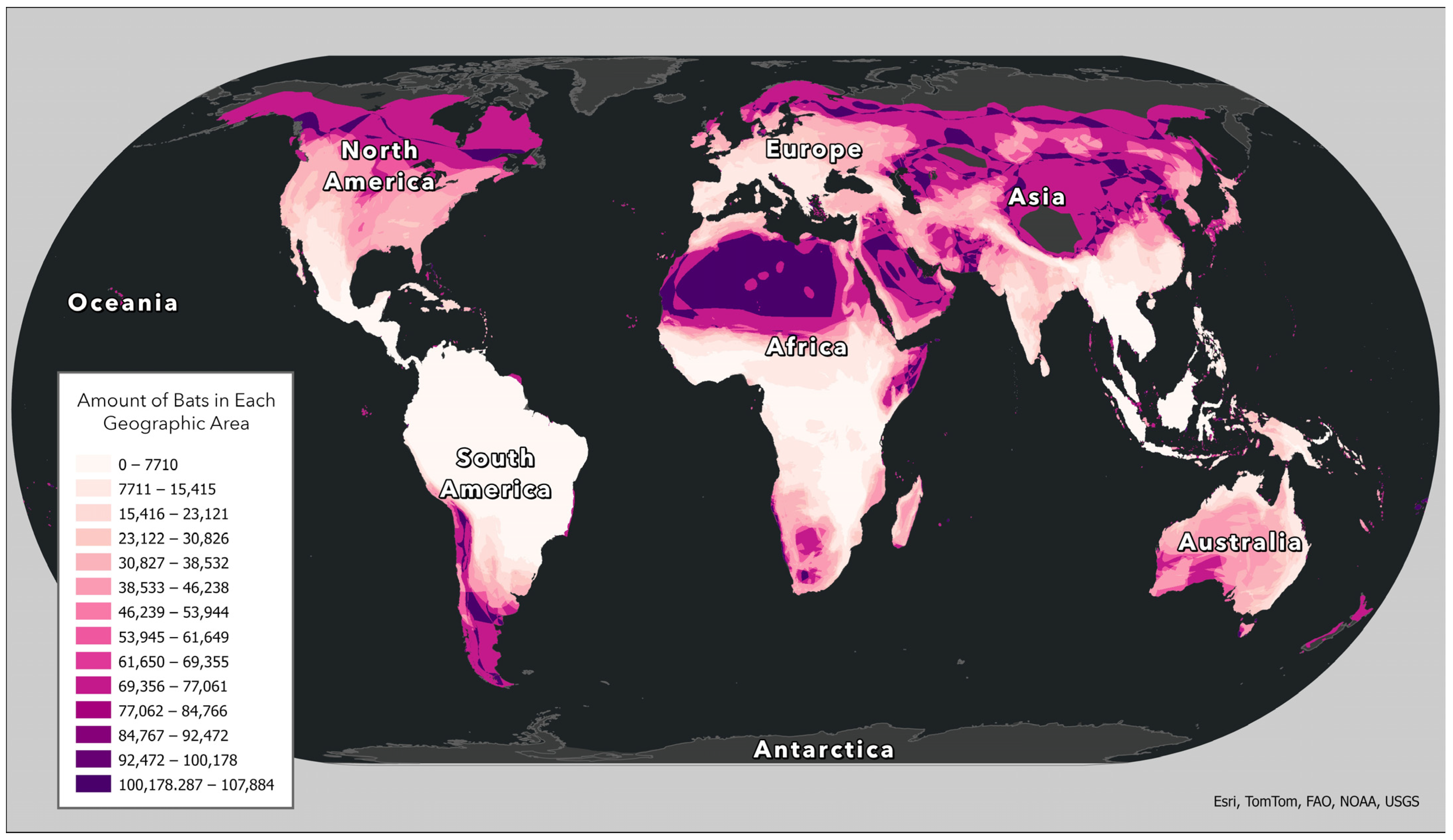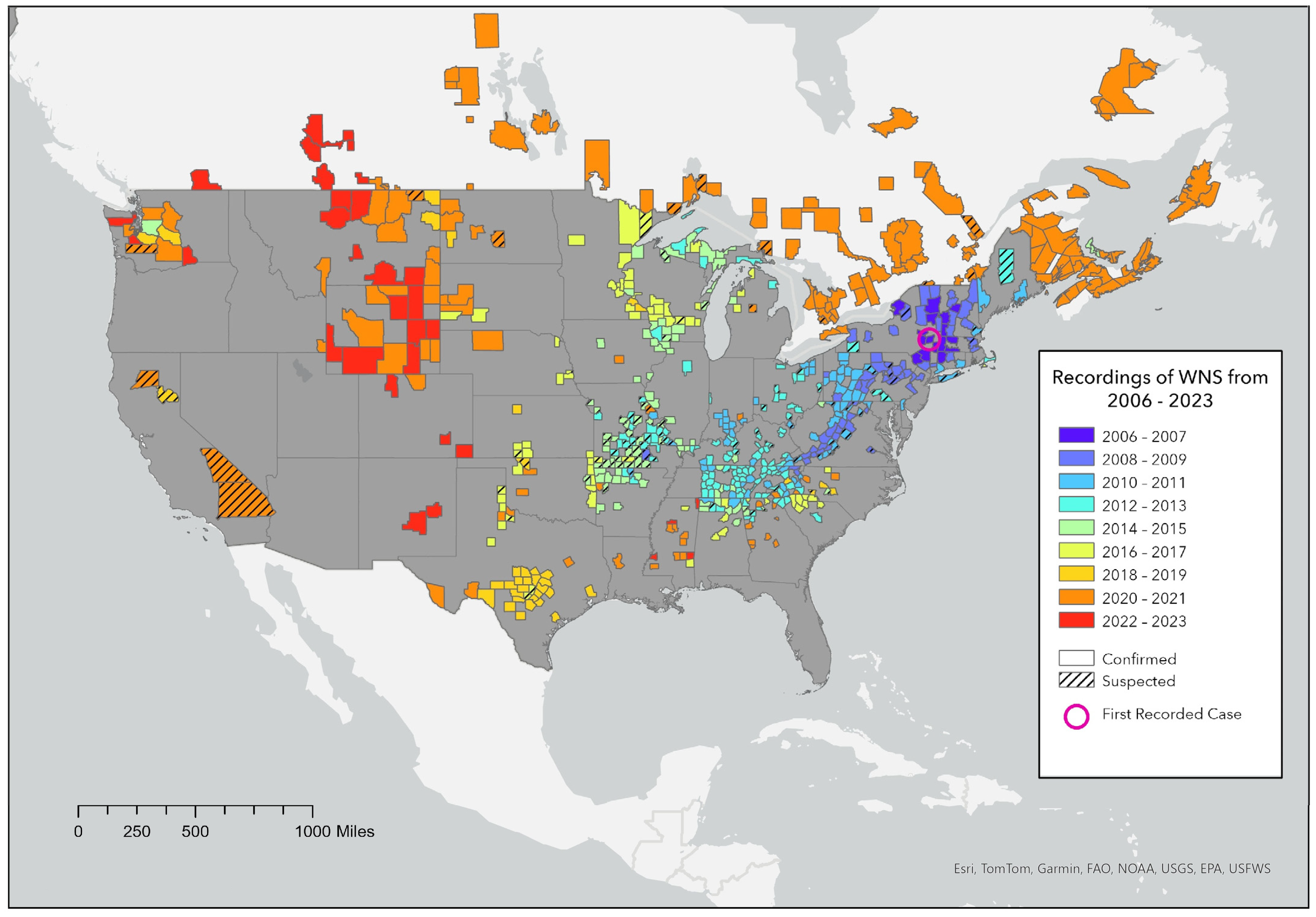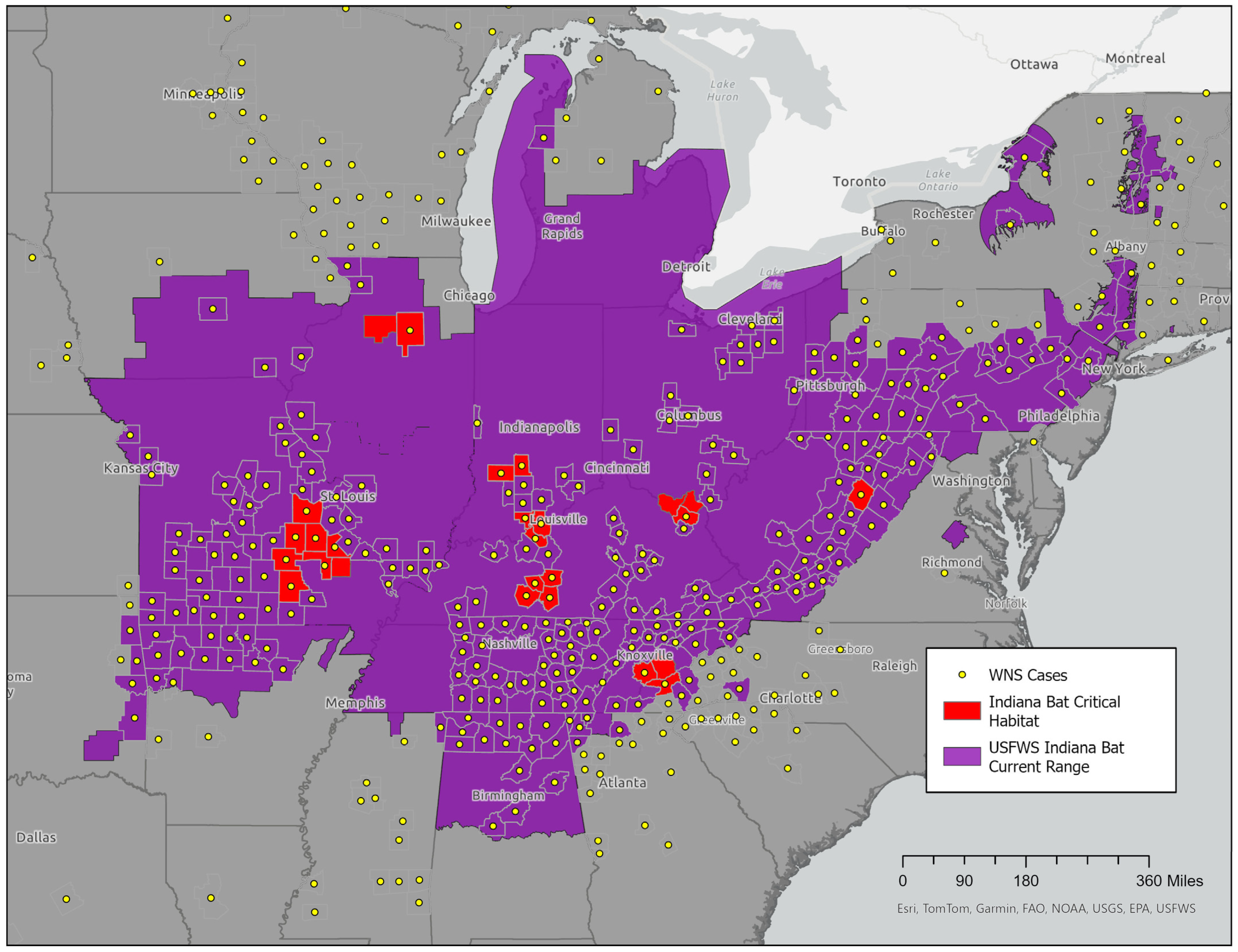Applying the Metacoupling Framework to Multi-Scalar Conservation Planning: An Analysis for the Endangered Indiana Bat
Abstract
1. Introduction
2. Background
2.1. Bats and Sustainability
2.2. Ecology and Spread of White-Nose Syndrome
2.3. Ecology and Conservation Challenges of the Indiana Bat
3. Materials and Methods
| Framework Component | Key References | Illustrative Focus/Contribution |
|---|---|---|
| Intracoupling (interactions within a system) | Cope et al. (1973); Harvey & McDaniel (1986); Brack (2007); Sherwin et al. (2012); Thogmartin & McKann (2014); Roby et al. (2019); IDNR; USFWS [15,16,17,35,36,40,41,42] | Local-scale dynamics of the Indiana bat, including hibernation microclimates, migration behavior, and the effects of climate variation on grouping and survival. |
| Pericoupling (interactions between adjacent systems) | Sáenz-Romero et al. (2012); Pauli et al. (2015); Apeti & N’Doua (2023) [10,20,25] | Regional landscape and genetic connectivity, forest management, and spillover effects from neighboring land-use and policy changes. |
| Telecoupling (interactions between distant systems) | Paguntalan et al. (2004); Liu et al. (2015); Bacigalupe et al. (2017); Hulina et al. (2017); López-Hoffman et al. (2017); Giudice et al. (2019); López-Wilchis et al. (2021); Kingston et al. (2023); Montti et al. (2024); Pfenning-Butterworth et al. (2024) [1,8,9,11,24,34,39,43,44,45] | Long-distance drivers such as global trade, tourism, migration, and pathogen spread, with comparative cases showing how remote pressures influence biodiversity and disease dynamics. |
| Metacoupling Integration (synthesis across scales) | Liu (2017; 2023); Büscher & Fletcher (2020); Newig et al. (2020); Sun (2023); Cheung et al. (2024) [2,3,4,5,6,7] | Conceptual and methodological integration of intra-, peri-, and telecoupled systems, offering guidance for applying the metacoupling framework to sustainability governance and policy. |
| Cross-cutting Conservation Context | Dzal et al. (2010); Kunz et al. (2011); Thogmartin et al. (2013); O’Keefe (2013); Voigt & Kingston (2016); López-Hoffman et al. (2017); Cheng et al. (2021); O’Rourke et al. (2021); Valle et al. (2021); Hoyt et al. (2021); IUCN Red List (2016; 2020); Beilke & O’Keefe (2022); Newman & Surrey (2025); USFWS; U.S. Department of the Interior; ADW; UN DESA [12,14,18,19,21,22,23,26,27,28,29,30,31,32,33,38,46,47] | Overarching studies on sustainability, bat conservation, global biodiversity loss, and disease ecology that inform all levels of coupling analysis. |
4. Results
4.1. The Telecoupling Framework and Its Relevance to Indiana Bat Conservation
4.2. The Metacoupling Framework and Its Relevance to Indiana Bat Conservation
4.3. Lessons from Applying the Metacoupling Framework to Other Bat Species
5. Discussion
5.1. Cross-Scale Conservation Insights and Sustainability Implications
5.2. Conservation Implications and Management Recommendations
5.3. Future Directions
6. Conclusions
Author Contributions
Funding
Institutional Review Board Statement
Informed Consent Statement
Data Availability Statement
Conflicts of Interest
References
- Pfenning-Butterworth, A.; Buckley, L.B.; Drake, J.M.; Farner, J.E.; Farrell, M.J.; Gehman, A.-L.M.; Mordecai, E.A.; Stephens, P.R.; Gittleman, J.L.; Davies, T.J. Interconnecting global threats: Climate change, biodiversity loss, and infectious diseases. Lancet Planet. Health 2024, 8, e270–e283. [Google Scholar] [CrossRef] [PubMed]
- Cheung, H.; Song, A.Y.; Di Marco, M.; Biggs, D. Policy diffusion in global biodiversity conservation: Learning, competition, coercion, and emulation amid US–China great-power politics. Conserv. Lett. 2024, 17, e13026. [Google Scholar] [CrossRef]
- Büscher, B.; Fletcher, R. (Eds.) The Conservation Revolution: Radical Ideas for Saving Nature Beyond the Anthropocene, 1st ed.; Verso Books: London, UK, 2020; pp. 1–230. [Google Scholar]
- Liu, J. Integration across a metacoupled World. Ecol. Soc. 2017, 22, 29. [Google Scholar] [CrossRef]
- Liu, J. Leveraging the metacoupling framework for Sustainability Science and Global Sustainable Development. Natl. Sci. Rev. 2023, 10, nwad090. [Google Scholar] [CrossRef]
- Sun, J. Understanding Ecosystem Services in a metacoupled World. Trans. Earth Environ. Sustain. 2023, 1, 46–54. [Google Scholar] [CrossRef]
- Newig, J.; Challies, E.; Cotta, B.; Lenschow, A.; Schilling-Vacaflor, A. Governing global telecoupling toward environmental sustainability. Ecol. Soc. 2020, 25, 21. [Google Scholar] [CrossRef]
- Liu, J.; Hull, V.; Luo, J.; Yang, W.; Liu, W.; Viña, A.; Vogt, C.; Xu, Z.; Yang, H.; Zhang, J.; et al. Multiple telecouplings and their complex interrelationships. Ecol. Soc. 2015, 20, 44. [Google Scholar] [CrossRef]
- Giudice, R.; Börner, J.; Wunder, S.; Cisneros, E. Selection biases and spillovers from collective conservation incentives in the Peruvian Amazon. Environ. Res. Lett. 2019, 14, 045004. [Google Scholar] [CrossRef]
- Apeti, A.E.; N’Doua, B.D. The impact of timber regulations on timber and timber product trade. Ecol. Econ. 2023, 213, 107943. [Google Scholar] [CrossRef]
- Montti, L.; Gasparri, N.I.; Grau, H.R. Telecoupling lens for integrating ecological and human dimensions of the biological invasion problem. Sustain. Sci. 2024, 19, 1139–1154. [Google Scholar] [CrossRef]
- Voigt, C.C.; Kingston, T. Bats in the Anthropocene: Conservation of Bats in a Changing World; Springer: Cham, Switzerland, 2016. [Google Scholar] [CrossRef]
- Mapping the World’s Biodiversity. Available online: https://biodiversitymapping.org/ (accessed on 1 August 2025).
- Animal Diversity Web (ADW). Available online: https://animaldiversity.org/accounts/Vespertilionidae/ (accessed on 3 August 2025).
- Brack, V. Temperatures and locations used by hibernating bats, including Myotis sodalis (Indiana bat), in a limestone mine: Implications for conservation and management. Environ. Manag. 2007, 40, 739–746. [Google Scholar] [CrossRef] [PubMed]
- U.S. Fish & Wildlife Service (USFWS). Indiana Bat (Myotis sodalis). Available online: https://www.fws.gov/species/indiana-bat-myotis-sodalis (accessed on 20 July 2025).
- Harvey, M.J.; McDaniel, V.R. Population Decline of the Endangered Indiana Bat, Myotis sodalis, in Arkansas. J. Ark. Acad. Sci. 1986, 40, 29. [Google Scholar]
- The IUCN Red List of Threatened Species 2016. Available online: https://www.iucnredlist.org/species/14136/22053184#assessment-information (accessed on 2 August 2025).
- Thogmartin, W.E.; Sanders-Reed, C.A.; Szymanski, J.A.; McKann, P.C.; Pruitt, L.; King, R.A.; Runge, M.C.; Russell, R.E. White-nose syndrome is likely to extirpate the endangered Indiana bat over large parts of its range. Biol. Conserv. 2013, 160, 162–172. [Google Scholar] [CrossRef]
- Pauli, B.P.; Zollner, P.A.; Haulton, G.S.; Shao, G.; Shao, G. The simulated effects of timber harvest on suitable habitat for Indiana and northern long-eared bats. Ecosphere 2015, 6, 1–24. [Google Scholar] [CrossRef]
- O’Keefe, J. Bats in Your Woods. Woodl. Steward. 2013, 22, 6–8. [Google Scholar]
- Kunz, T.H.; Braun de Torrez, E.; Bauer, D.; Lobova, T.; Fleming, T.H. Ecosystem Services provided by bats. Ann. N. Y. Acad. Sci. 2011, 1223, 1–38. [Google Scholar] [CrossRef]
- Dzal, Y.; McGuire, L.P.; Veselka, N.; Fenton, M.B. Going, going, gone: The impact of white-nose syndrome on the summer activity of the little brown bat (myotis lucifugus). Biol. Lett. 2010, 7, 392–394. [Google Scholar] [CrossRef]
- López-Hoffman, L.; Diffendorfer, J.; Wiederholt, R.; Bagstad, K.J.; Thogmartin, W.E.; McCracken, G.; Medellin, R.L.; Russell, A.; Semmens, D.J. Operationalizing the telecoupling framework for migratory species using the spatial subsidies approach to examine ecosystem services provided by Mexican free-tailed bats. Ecol. Soc. 2017, 22, 23. [Google Scholar] [CrossRef]
- Sáenz-Romero, C.; Rehfeldt, G.E.; Duval, P.; Lindig-Cisneros, R.A. Abies religiosa habitat prediction in climatic change scenarios and implications for Monarch Butterfly Conservation in Mexico. For. Ecol. Manag. 2012, 275, 98–106. [Google Scholar] [CrossRef]
- United Nations Department of Economic and Social Affairs Sustainable Development (UN DESA). Available online: https://sdgs.un.org/2030agenda (accessed on 25 October 2025).
- Beilke, E.A.; O’Keefe, J.M. Bats reduce insect density and defoliation in temperate forests: An exclusion experiment. Ecology 2022, 104, e3903. [Google Scholar] [CrossRef]
- Newman, C.; Surrey, K.C. The costs of wind energy permitting compliance actions for regulated bats in the US. PLoS ONE 2025, 20, e0322005. [Google Scholar] [CrossRef]
- Valle, D.; Griffith, D.M.; Jara-Guerrero, A.; Armijos-Ojeda, D.; Espinosa, C.I. A multifaceted approach to understanding bat community response to disturbance in a seasonally dry tropical forest. Sci. Rep. 2021, 11, 5667. [Google Scholar] [CrossRef]
- O’Rourke, D.R.; Mangan, M.T.; Mangan, K.E.; Bokulich, N.A.; MacManes, M.D.; Foster, J.T. Lord of the Diptera (and Moths and a spider): Molecular diet analyses and foraging ecology of Indiana bats in Illinois. Front. Ecol. Evol. 2021, 9, 623655. [Google Scholar] [CrossRef]
- Hoyt, J.R.; Kilpatrick, A.M.; Langwig, K.E. Ecology and impacts of white-nose syndrome on bats. Nat. Rev. Microbiol. 2021, 19, 196–210. [Google Scholar] [CrossRef]
- Cheng, T.L.; Reichard, J.D.; Coleman, J.T.; Weller, T.J.; Thogmartin, W.E.; Reichert, B.E.; Bennett, A.B.; Broders, H.G.; Campbell, J.; Etchison, K.; et al. The scope and severity of white-nose syndrome on hibernating bats in North America. Conserv. Biol. 2021, 35, 1586–1597. [Google Scholar] [CrossRef]
- U.S. Fish and Wildlife Service (USFWS). Range-Wide Indiana Bat and Northern Long-Eared Bat Survey Guidelines. Available online: https://www.fws.gov/media/range-wide-indiana-bat-and-northern-long-eared-bat-survey-guidelines (accessed on 9 July 2025).
- Bacigalupe, L.D.; Soto-Azat, C.; García-Vera, C.; Barría-Oyarzo, I.; Rezende, E.L. Effects of amphibian phylogeny, climate and human impact on the occurrence of the amphibian-killing Chytrid fungus. Glob. Change Biol. 2017, 23, 3543–3553. [Google Scholar] [CrossRef]
- IDNR. Conservation Guidance for the Indiana Bat (Myotis sodalis); Illinois Department of Natural Resources, Division of Natural Heritage: Springfield, IL, USA, 2017. [Google Scholar]
- Cope, J.B.; Richter, A.R.; Mills, R.S. A Summer Concentration of the Indiana Bat, Myotis sodalis, in Wayne County, Indiana. Proc. Indiana Acad. Sci. 1973, 83, 482–484. [Google Scholar]
- Bat Conservation Trust, Overview—White-Nose Syndrome. Available online: https://www.bats.org.uk/about-bats/threats-to-bats/white-nose-syndrome/overview (accessed on 30 August 2025).
- López-Hoffman, L.; Chester, C.C.; Semmens, D.J.; Thogmartin, W.E.; Rodríguez-McGoffin, M.S.; Merideth, R.; Diffendorfer, J.E. Ecosystem services from Transborder Migratory Species: Implications for Conservation Governance. Annu. Rev. Environ. Resour. 2017, 42, 509–539. [Google Scholar] [CrossRef]
- López-Wilchis, R.; Méndez-Rodríguez, A.; Juste, J.; Serrato-Díaz, A.; Rodríguez-Gómez, F.; Guevara-Chumacero, L.M. Genetic consequences of forest fragmentation in a widespread forest bat (natalus mexicanus, Chiroptera: Natalidae). Diversity 2021, 13, 140. [Google Scholar] [CrossRef]
- Roby, P.L.; Gumbert, M.W.; Lacki, M.J. Nine Years of Indiana bat (Myotis sodalis) spring migration behavior. J. Mammal. 2019, 100, 1501–1511. [Google Scholar] [CrossRef]
- Sherwin, H.A.; Montgomery, W.I.; Lundy, M.G. The impact and implications of climate change for bats. Mammal Rev. 2012, 43, 171–182. [Google Scholar] [CrossRef]
- Thogmartin, W.E.; McKann, P.C. Large-scale climate variation modifies the winter grouping behavior of endangered Indiana Bats. J. Mammal. 2014, 95, 117–127. [Google Scholar] [CrossRef]
- Hulina, J.; Bocetti, C.; Campa, H.; Hull, V.; Yang, W.; Liu, J. Telecoupling framework for research on Migratory Species in the anthropocene. Elem. Sci. Anthr. 2017, 5, 5. [Google Scholar] [CrossRef]
- Kingston, T.; Florens, F.B.V.; Vincenot, C.E. Large Old World Fruit Bats on the brink of extinction: Causes and consequences. Annu. Rev. Ecol. Evol. Syst. 2023, 54, 237–257. [Google Scholar] [CrossRef]
- Paguntalan, L.M.J.; Pedregosa, M.G.; Gadiana, M.J.C. The Philippine bare-backed fruit bat Dobsonia chapmani Rabort, 1952: Rediscovery and conservation status on Cebu Island. Silliman J. 2004, 45, 113–122. [Google Scholar]
- The IUCN Red List of Threatened Species 2020. Available online: https://www.iucnredlist.org/species/6773/22033978 (accessed on 20 July 2025).
- U.S. Department of the Interior, Hibernate or Migrate, National Parks Service. Available online: https://www.nps.gov/subjects/bats/hibernate-or-migrate.htm#::text=Many%20species%20of%20bats%20move,winter%20when%20insects%20become%20scarce (accessed on 1 September 2025).
- National Academies of Sciences, Engineering, and Medicine. A Vision for Continental-Scale Biology: Research Across Multiple Scales; The National Academies Press: Washington, DC, USA, 2025. [Google Scholar] [CrossRef]




| Components | Conventional Framework for Studying and Conserving Indiana Bats | Telecoupling Framework for Studying and Conserving Indiana Bats | New Conservation Actions |
|---|---|---|---|
| Systems- Features | Natural systems (bat populations, hibernacula, summer roosts) | Coupled human and natural systems (bats linked with forestry, agriculture, urban areas, and tourism) | Incorporate human dimensions into conservation across distant places; minimize impacts and enhance mutual benefits. |
| Systems- Types | Known habitats (hibernacula, summer roosts, foraging locations) | Local and distant systems influencing bats (e.g., timber markets, agriculture, climate change) | Manage distant systems affecting bats; coordinate cross-scale habitat and policy management |
| Agents | Bats, scientists, wildlife/land managers, landowners, tourists, government agencies | All local agents plus distant actors (timber trade, agriculture, NGOs, consumers) | Engage all agents and facilitate cooperation among all types of agents across distant places. Foster cooperation among diverse agents across distant places and sectors |
| Flows | Bat movements and migrations, spread of White-Nose Syndrome | Environmental and socioeconomic flows (disease spread, trade, funding, knowledge) | Limit harmful flows (e.g., disease, trade-driven loss); promote beneficial flows (e.g., research, funding, education) |
| Causes | Environmental stressors (habitat loss, disturbance, and disease) | Environmental and socioeconomic factors (land-use policy, consumer demand for timber, global trade, public perception) | Create and use incentives (e.g., subsidies, cave access regulation, awareness campaigns) to reduce pressures across distant systems |
| Effects | Impacts on bat populations, health, and habitats | Impacts on both bat populations and humans (e.g., pest control, cultural values, disease risks) | Reduce ecological–socioeconomic trade-offs and enhance positive outcomes for bats and humans |
| Feedback | Environmental feedback (loss of roosts reduces population resilience) | Environmental and socioeconomic feedback (e.g., loss of bats increases pesticide use, driving habitat degradation and land-use change) | Manage feedback across systems; emphasize bats’ ecosystem services to reinforce conservation incentives |
| Coupling Type | Definition (Conservation Context) | Indiana Bat Example | Conservation Actions |
|---|---|---|---|
| Intracoupling (within-system interactions) | Interactions within a single local system (e.g., community, county) | Local land-use decisions, cave closures, community attitudes | Promote habitat stewardship, protect roost trees, strengthen ordinances, community outreach |
| Pericoupling (adjacent-system interactions) | Interactions between neighboring systems (e.g., counties, states) | Logging displaced across borders; bats migrating across jurisdictions | Coordinate migration corridors, align land-use policies, develop regional timber standards |
| Telecoupling (distant-system interactions) | Interactions between distant systems linked through ecological or socioeconomic flows | Spread of White-Nose Syndrome, global timber trade, ecotourism, climate change | Enforce global cave hygiene protocols, regulate global timber trade, promote global awareness/funding, monitor climate impacts |
| Metacoupling (integration of all three types of coupling) | Combined framework using intracoupling, pericoupling, and telecoupling simultaneously | Regional development altering local land use (intracoupling), shifting logging to adjacent forests (pericoupling), and increasing distant ecotourism flows into caves (telecoupling) | Design multi-scalar strategies addressing local, regional, and global pressures together |
Disclaimer/Publisher’s Note: The statements, opinions and data contained in all publications are solely those of the individual author(s) and contributor(s) and not of MDPI and/or the editor(s). MDPI and/or the editor(s) disclaim responsibility for any injury to people or property resulting from any ideas, methods, instructions or products referred to in the content. |
© 2025 by the authors. Licensee MDPI, Basel, Switzerland. This article is an open access article distributed under the terms and conditions of the Creative Commons Attribution (CC BY) license (https://creativecommons.org/licenses/by/4.0/).
Share and Cite
Sharp, C.; Liu, J. Applying the Metacoupling Framework to Multi-Scalar Conservation Planning: An Analysis for the Endangered Indiana Bat. Sustainability 2025, 17, 10339. https://doi.org/10.3390/su172210339
Sharp C, Liu J. Applying the Metacoupling Framework to Multi-Scalar Conservation Planning: An Analysis for the Endangered Indiana Bat. Sustainability. 2025; 17(22):10339. https://doi.org/10.3390/su172210339
Chicago/Turabian StyleSharp, Cori, and Jianguo Liu. 2025. "Applying the Metacoupling Framework to Multi-Scalar Conservation Planning: An Analysis for the Endangered Indiana Bat" Sustainability 17, no. 22: 10339. https://doi.org/10.3390/su172210339
APA StyleSharp, C., & Liu, J. (2025). Applying the Metacoupling Framework to Multi-Scalar Conservation Planning: An Analysis for the Endangered Indiana Bat. Sustainability, 17(22), 10339. https://doi.org/10.3390/su172210339







